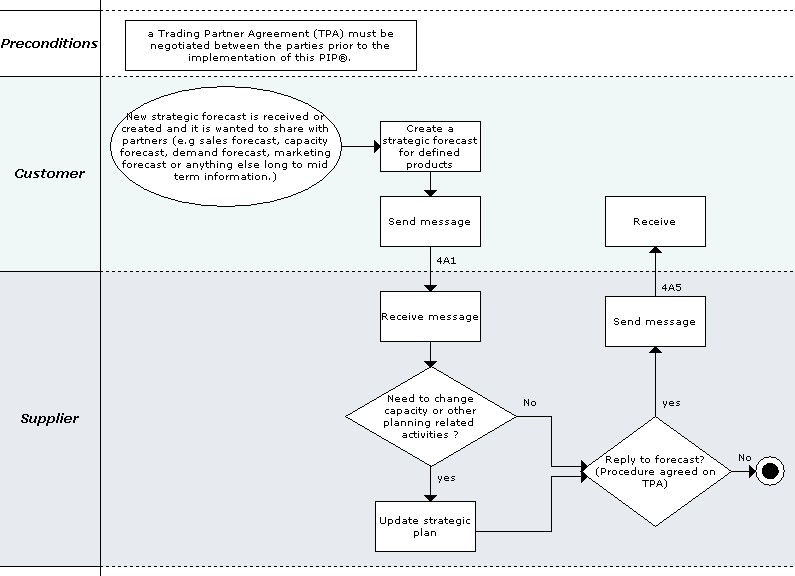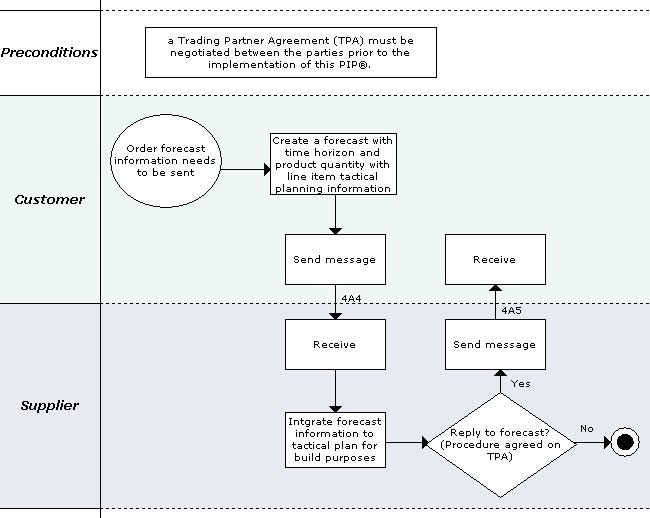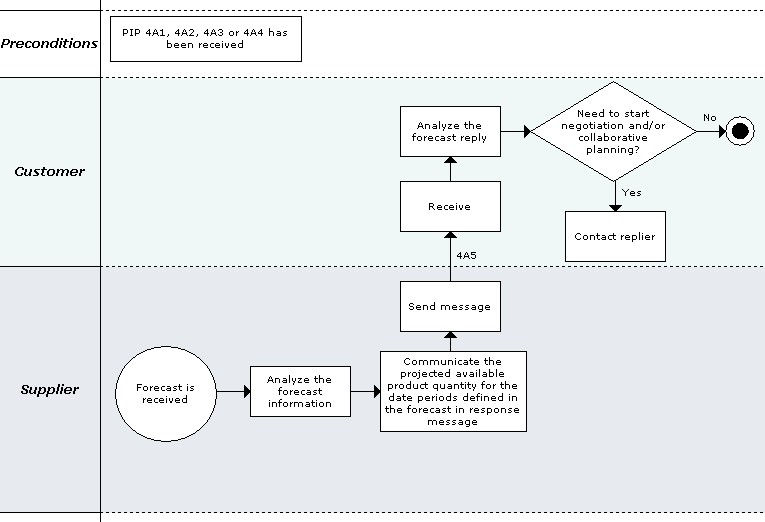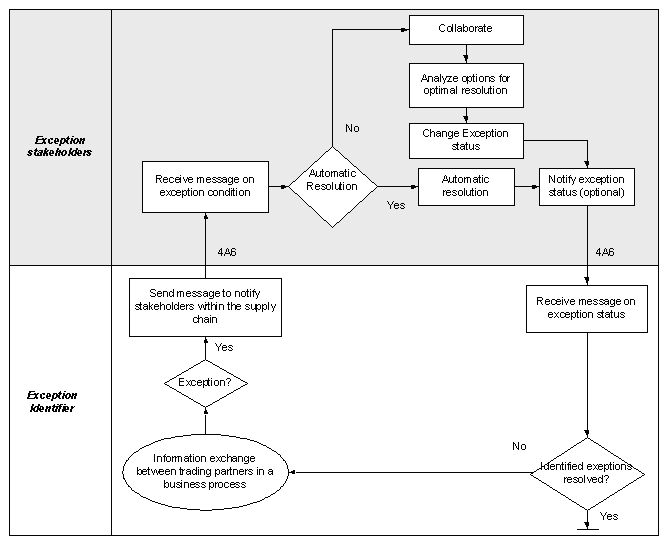| 4A1 | Notify of Strategic Forecast |
|---|---|
| Provides a process for developing standardized collaborative sales forecasts between two trading partners for the purpose of projecting anticipated product sales. |
Download Collaborative Forecasting specifications.
- 4A1_NotifyOfStrategicForecast_V02_00_00
- PIP4A1_V11.00.00_NotifyOfStrategicForecast
- 4A2_NotifyOfEmbeddedReleaseForecast_V02_00_00
- PIP4A2_V11.00.00_NotifyOfEmbeddedReleaseForecast
- 4A3_NotifyOfThresholdReleaseForecast_V01_00_00
- 4A3_NotifyOfThresholdReleaseForecast_V02_00_00
- 4A3_NotifyOfThresholdReleaseForecast_V02_01_00
- 4A3_NotifyOfThresholdReleaseForecast_V02_02_00
- 4A3_NotifyOfThresholdReleaseForecast_V02_03_00
- PIP4A3_V11.00.00_NotifyOfThresholdReleaseForecast
- 4A4_NotifyOfForecast_V01_00_00
- 4A4_NotifyOfPlanningReleaseForecast_V03_00_00
- PIP4A4_V11.00.00_NotifyOfPlanningReleaseForecast
- 4A5_NotifyOfForecastReply_V01_00_00
- 4A5_NotifyOfForecastReply_V02_00_00
- PIP4A5_V11.00.00_NotifyOfForecastReply
- 4A6_NotifyOfForecastingException_R01_00_00A
- Cluster 4: Inventory Management, enables inventory management, including collaboration, replenishment, price protection, reporting and allocation of constrained product.
- PIPs for Segment 4A: Collaborative Forecasting, enables standardization of collaborative order and sales forecasting between supply-chain partners.
| PIP | Title | Description |
|---|---|---|
| 4A1 | Notify of Strategic Forecast | Provides a process for developing standardized collaborative sales forecasts between two trading partners for the purpose of projecting anticipated product sales. |
| 4A2 | Notify of Embedded Release Forecast | Provides a process for developing standardized collaborative order forecasts between two trading partners. |
| 4A3 | Notify of Threshold Release Forecast | Provides a process for developing standardized collaborative order forecasts between two trading partners. |
| 4A4 | Notify of Planning Release Forecast | This PIP enables a retailer/distributor to send an order forecast to a supplier/manufacturer. |
| 4A5 | Notify of Forecast Reply | The purpose of this PIP is to provide visibility of available forecasted product quantity between two trading partners. |
| 4A6 | Notify of Forecasting Exception | This PIP supports a process where an Exception Identifier notifies an Exception Recipient of identified exceptions within a collaborative forecasting process. |
Business Process

The "Notify of Strategic Forecast" Partner Interface Process (PIP) supports a process in which a forecast owner sends forecast data to a forecast recipient. The forecast is informational only. This may be any kind of forecast including but not limited to a sales forecast, capacity forecast, demand forecast, marketing forecast, or master scheduler pre-MRP run forecast. It is usually a mid-term to long-term forecast. There is no implied or embedded automated mechanism to trigger shipment release to the forecast owner. For information on forecasting processes that result in shipment release authorizations, please refer to PIP4A2, "Notify of Embedded Release Forecast," PIP4A3, "Notify of Threshold Release Forecast" and PIP4A4, "Notify of Planning Release Forecast."
In accordance with the Start State (section 3.4), a Trading Partner Agreement (TPA) must be negotiated between the parties prior to the implementation of this PIP. The TPA should contain, but is not limited to, the following information:
- Define which products or product families are to be included in the forecast.
- Describe a procedure for adding products or product families to the forecast.
- Describe a procedure for removing products or product families from the forecast.
- Define the forecast transmission frequency.
- Describe quantity definitions and netting procedures if needed, for example; using gross quantities versus net quantities.
- Describe date definitions, for example; using scheduled dock dates versus scheduled ship dates.
The recipient may optionally respond to the forecast using PIP4A5, "Notify of Forecast Reply," if mutually agreed upon. The legal liability associated with forecast reply should be defined in the TPA.
This PIP is a one-way push of information. The communication process ensures that the forecast owner receives a non-repudiated acknowledgment of receipt, but does not require a confirmation or commitment from the forecast recipient.
Should this transaction not complete successfully, the requesting partner executes PIP0A1, "Notification of Failure".
| 4A2 | Notify of Embedded Release Forecast |
|---|---|
| Provides a process for developing standardized collaborative order forecasts between two trading partners. |
Business Process

The "Notify of Embedded Release Forecast" Partner Interface Process (PIP) supports a process in which a forecast owner sends forecast data to a forecast recipient. The embedded release forecast contains product demand information (planning demand) and/or product release information (firm demand).
It is intended that the demand information be integrated in the forecast recipient’s tactical build plan. The product release information grants the forecast recipient authorization to ship product. The authorization (shipment release) is expressed by either:
A ship authorization indicator, equal to Yes, for a specific line item (product) and forecast period, or
Defining a frozen time zone, which authorizes release of all line items (product) for the specified forecast period.
Either expression notifies the forecast recipient of the forecast owner’s commitment to accept delivery of the designated product(s) for the specified time period. Typically, the forecast recipient is observing the migration of planning demand into firm demand.
The typical frequency of forecast transmissions is, at a minimum, weekly.
In accordance with the Start State (section 3.4), a Trading Partner Agreement (TPA) must be negotiated between the parties prior to the implementation of this PIP. The TPA should contain, but is not limited to, the following information:
Identify legal contact information, for example; name, address, e-mail, telephone.
Define which products are to be included in the forecast.
Describe a procedure for adding products to the forecast.
Describe a procedure for removing products from the forecast.
Define the forecast transmission frequency.
Describe pricing procedures.
Describe quantity definitions and netting procedures if needed, for example; using gross quantities versus net quantities.
Describe date definitions, for example; using scheduled dock dates versus scheduled ship dates.
Describe manufacturer’s planning horizon (forecast recipient’s requirements) and forecast horizon (forecast owner’s requirements), for example; forecast recipient may require 12 weeks of data for planning; forecast owner may send 26 weeks of forecast data.
Define financial liability (trade off zone).
Determine the shipment authorization trigger to use, for example; choose frozen zone or ship authorization indicator.
Identify transfer of title.
Describe billing and payment cycles.
If a consignment process is being implemented, then identify consignment stock level controls and the trigger for billing, which is the notification of consumption. This notification of consumption may be communicated in some other mutually agreed upon PIP®.
As part of the End State, it will be assumed the forecast recipient integrates the forecast information into their build plan after each forecast transmission is sent, and ships product to the specified locations according to the shipment release information.
This PIP is a one-way push of information. The communication process ensures that the forecast owner receives a non-repudiated acknowledgment of receipt, but does not require a confirmation or commitment from the forecast recipient.
The forecast recipient may optionally respond to the forecast using PIP4A5, "Notify of Forecast Reply" if mutually agreed upon. The legal liability associated with forecast reply is defined in the TPA.
Should this transaction not complete successfully, the requesting partner executes PIP0A1, "Notification of Failure".
| 4A3 | Notify of Threshold Release Forecast |
|---|---|
| Provides a process for developing standardized collaborative order forecasts between two trading partners. |
Business Process

The "Notify of Threshold Release Forecast" Partner Interface Process (PIP) supports a process in which a forecast owner sends forecast data to a forecast recipient. The threshold release forecast contains product demand information (planning demand), current product inventory levels (on-hand quantity), and target product inventory levels (minimum/maximum). The forecast also contains optional shipment receipt information.
It is intended that the product demand information be sent directly into the forecast recipient’s tactical build plan. The target inventory levels define a minimum or maximum (threshold) level of desired inventory. The demand, inventory, and receipt information allows the forecast recipient to calculate shipment releases. With this PIP, inventory management responsibility is transferred to the forecast recipient. The typical frequency of forecast transmissions is, at a minimum, weekly.
In accordance with the Start State (section 3.4), a Trading Partner Agreement (TPA) must be negotiated between the parties prior to the implementation of this PIP. The TPA should contain, but is not limited to, the following information:
Identify legal contact information, for example; name, address, e-mail, telephone.
Define which products are to be included in the forecast.
Describe a procedure for adding products to the forecast.
Describe a procedure for removing products from the forecast.
Define the forecast transmission frequency.
Describe pricing procedures.
Describe quantity definitions and netting procedures if needed, for example; using gross quantities versus net quantities.
Describe date definitions, for example; using scheduled dock dates versus scheduled ship dates.
Describe manufacturer’s planning horizon (forecast recipient’s requirements) and forecast horizon (forecast owner’s requirements); for example; forecast recipient may require 12 weeks of data for planning, forecast owner may send 26 weeks of forecast data.
Define financial liability (trade off zone).
Identify transfer of title.
Describe billing and payment cycle
Define non-consignment or consignment stock level controls (on-hand quantity, minimum and/or maximum quantity).
If a consignment process is being implemented, then identify the trigger for billing which is the notification of consumption. This notification of consumption should be communicated in some mutually agreed upon PIP®.
As part of the End State, it will be assumed the forecast recipient 1) integrates the forecast information into their build plan after each forecast transmission is sent, 2) calculates shipment releases, 3) ships product to the specified locations.
This PIP is a one-way push of information. The communication process ensures that the forecast owner receives a non-repudiated acknowledgment of receipt, but does not require a confirmation or commitment from the recipient.
The recipient may optionally respond to the forecast using PIP4A5, "Notify of Forecast Reply" if mutually agreed upon. The legal liability associated with forecast reply is defined in the TPA.
Should this transaction not complete successfully, the requesting partner executes PIP0A1, "Notification of Failure".
| 4A4 | Notify of Planning Release Forecast |
|---|---|
| This PIP enables a retailer/distributor to send an order forecast to a supplier/manufacturer. |
Business Process

The "Notify of Forecast" Partner Interface Process (PIP) supports a process in which a retailer/distributor sends an order forecast to a supplier/manufacturer. The forecast includes line item tactical planning information that can be used for build purposes. The data shared in the forecast, such as forecast time horizon and product quantity, are specified in the trading partner agreement (TPA). The communication process ensures that the retailer/distributor receives a non-repudiated acknowledgment of receipt, but it does not return a confirmation or commitment from the supplier/manufacturer.
The supplier/manufacturer may respond to the order forecast using PIP4A5, "Notify of Forecast Confirmation." The legal liability associated with forecast responses is defined in the TPA.
Trading partners may implement collaborative forecasting and identify exceptions by iteratively using PIP4A4, "Notify of Forecast" and PIP4A5, "Notify of Forecast Confirmation" to exchanges forecasts and confirmations.
Should this transaction not complete successfully, the requesting partner executes PIP0A1, "Notification of Failure".
| 4A5 | Notify of Forecast Reply |
|---|---|
| The purpose of this PIP is to provide visibility of available forecasted product quantity between two trading partners. |
Business Process

Previously received forecast. A forecast may have been sent in the form of a RosettaNet PIP (PIP4A1, “Notify of Strategic Forecast,” PIP4A2, “Notify of Embedded Release Forecast,” PIP4A3, “Notify of Threshold Release Forecast” or PIP4A4, “Notify of Planning Release Forecast”) or some other electronic exchange of data including EDI forecasts. Via the forecast reply, the forecast recipient communicates the projected available product quantity for the date periods defined in the forecast.
Forecast reply transmissions must occur in a timely manner in order for the forecast reply recipient to receive and interpret the reply data, before the next forecast is created. Trading partners may implement collaborative forecasting methods by using iterative exchanges of the forecast PIPs (referred to in the previous paragraph), and using PIP4A5, “Notify of Forecast Reply.” These iterative exchanges will be indexed by identification and revision numbers, which will allow the forecast reply recipient to match the reply to the appropriate forecast.
Legal liability associated with the forecast reply is defined in the Trading Partner Agreement (TPA).
In accordance with the Start State (section 3.4), a TPA must be negotiated between the parties prior to the implementation of this PIP. The TPA should contain, but is not limited to, the following information:
Identify legal contact information, for example; name, address, e-mail, telephone.
Define which products or product families are to be included in the forecast reply.
Define the forecast transmission frequency.
Describe quantity definitions and netting procedures if needed, for example; using gross quantities versus net quantities.
Describe date definitions, for example; using scheduled dock dates versus scheduled ship dates.
Describe manufacturer’s planning horizon (forecast recipient’s requirements) and forecast horizon (forecast reply recipient’s requirements); for example; forecast recipient may require 12 weeks of data for planning; forecast reply recipient may send 26 weeks of forecast data. The forecast recipient would then reply to 12 weeks of data.
Define financial and/or legal liability (or lack thereof).
Define forecast exception management (issue resolution) process.
This PIP is a one-way push of information. The communication process ensures that the forecast recipient receives a non-repudiated acknowledgment of receipt, but does not require a confirmation or commitment from the forecast reply recipient.
Should this transaction not complete successfully, the requesting partner executes PIP0A1, "Notification of Failure".
| 4A6 | Notify of Forecasting Exception |
|---|---|
| This PIP supports a process where an Exception Identifier notifies an Exception Recipient of identified exceptions within a collaborative forecasting process. |
Business Process

An Exception is an indication for an unplanned event or a potential problem. When initiating a collaboration process, trading partners agree in the Trading Partner Agreement (TPA) or in other service contract on the exception conditions that require attention for resolution. Exceptions are identified by monitoring the supply chain and information shared in the business process. The identified exceptions should trigger a focused exception management process between relevant stakeholders within the supply chain.
Exception Criteria set the baseline for identifying exception conditions for resolution by the trading partners. The exception management process is dependent upon trading partners agreeing to the exception criteria in their Trading Partner Agreement (TPA) or service contract. The exception criteria determine the supply chain information and metrics to be monitored by the trading partners, and the rules on when an exception condition occurs. The exception criteria include definition of exception types and exception tolerances.
PIP 4A6 "Notify of Forecasting Exception" supports a process where an Exception Identifier notifies an Exception Recipient of identified exceptions within a collaborative forecasting process. Figure 1 Generic Exception Management Process describes use of this PIP regardless of whether a strategic forecast, an order forecast, or a replenishment process is in question. The identified exceptions should trigger a focused exception management process between the Exception Identifier and Exception Recipient. As indicated in the figure, exception stakeholders are the relevant parties that need visibility to a specific exception or should resolve that exception within a supply chain. Typically, stakeholders include both the Exception Identifier and Exception Recipient.
Should this transaction not complete successfully, the requesting partner executes PIP0A1, "Notification of Failure".
